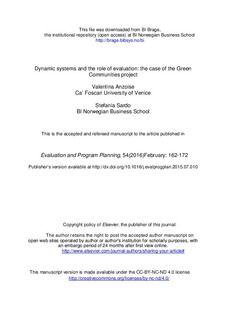Dynamic systems and the role of evaluation: the case of the Green Communities project
Journal article, Peer reviewed
Permanent lenke
http://hdl.handle.net/11250/2422323Utgivelsesdato
2016Metadata
Vis full innførselSamlinger
- Scientific articles [2181]
Originalversjon
Evaluation and Program Planning, 54(2016)February: 162-172 http://dx.doi.org/10.1016/j.evalprogplan.2015.07.010Sammendrag
The crucial role evaluation can play in the co-development of project design and its
implementation will be addressed through the analysis of a case study, the Green Communities
(GC) project, funded by the Italian Ministry of Environment within the EU Interregional
Operational Program (2007-2013) “Renewable Energy and Energy Efficiency”. The project’s
broader goals included an attempt to trigger a change in Italian local development strategies,
especially for mountain and inland areas, which would be tailored to the real needs of
communities, and based on a sustainable exploitation and management of the territorial assets.
The goal was not achieved, and this paper addresses the issues of how GC could have been
more effective in fostering a vision of change, and which design adaptations and evaluation
procedures would have allowed the project to better cope with the unexpected consequences
and resistances it encountered. The conclusions drawn are that projects should be conceived,
designed and carried out as dynamic systems, inclusive of a dynamic and engaged evaluation
enabling the generation of feedbacks loops, iteratively interpreting the narratives and dynamics
unfolding within the project, and actively monitoring the potential of various relationships
among project participants for generating positive social change.
Beskrivelse
This is the accepted and refereed manuscript to the article
